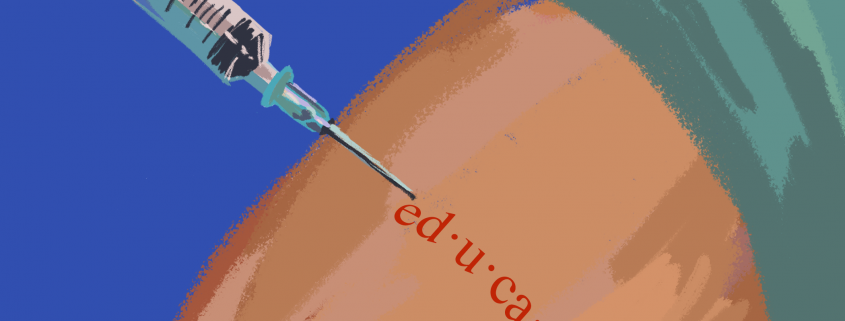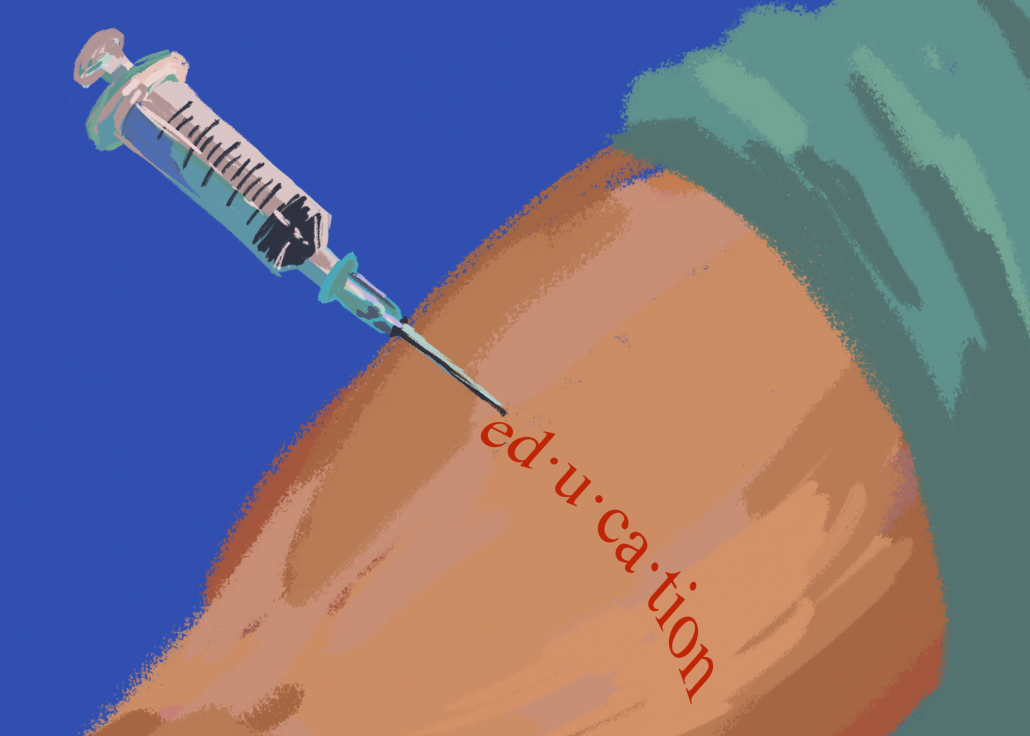Coronavirus highlights the country’s educational woes
When the Food and Drug Administration granted emergency authorization to the Pfizer-BioNtech coronavirus vaccine back in December 2020, it seemed as if the end of the pandemic was on the horizon. Almost nine months and full FDA approval later, the end seems further away than before.
Vaccination rates have plateaued since June 2021. Currently, only 52.6% of the country is fully vaccinated. This subpar rate is not due to a lack of supply or logistical execution. It is due to a tirade of misinformation. Fake news and pseudoscience have built a stronghold into the minds of too many Americans. Instead of trusting accredited scientists, individuals drift through Facebook-driven conspiracy theories and call it “doing their own research.”
Unfortunately, this paradigm is far from unfamiliar and continues to repeat itself because of a broken education system. When less than 3% of federal spending accounts for education, the result is millions of Americans struggling to differentiate scientific facts from propaganda.
However, the problems go beyond just insufficient funding. Systemic inequity due to race and economic status has also spearheaded the downfall of education in this country.
The U.S. Federal budget will be an estimated $6 trillion for the fiscal year of 2022. From that, education receives a meager $66.6 billion. In comparison, the United Kingdom’s national budget is £1 trillion and education accounts for about £100 billion. The British quantitative emphasis on education surpasses the U.S. both relatively and absolutely.
It is a rather embarrassing statistic for the U.S. The group to blame for it is none other than big-money lobbyists.
To demonstrate their impact, analyze this simple — yet staggering — fact. From 1998 to 2011, Pentagon spending increased from $367 billion — relative to the 2010 value of the dollar — to nearly $690 billion. In that same time span, defense lobbyists increased from 611 to 952. Defense contractors have used their lobbyist soldiers to ensure tax-breaks and increased funding for the defense sector.
While education lobbyists also exist, they do not hold nearly the same amount of power as defense lobbyists. Simply, the defense sector brings in greater political donations from fewer clients. In 2021, defense lobbying raked in nearly $58 million from 199 clients. Meanwhile, education lobbying amounted to $41 million from 581 clients.
Taking donations from the defense sector equates to a greater volume of money and fewer clients for politicians to appease. It is a sad reality that political donations dictate the academic well-being of children in the U.S.
Shifting from an economic to a social perspective, there are numerous consequences from a broken education system. The most current being the subpar coronavirus vaccination numbers. Among the 11 states with the lowest rates, seven — West Virginia, Georgia, Alabama, South Carolina, Idaho, Mississippi, Tennessee — rank among the bottom 20 states in education in the country. This cannot be a coincidence.
Furthermore, adults with a bachelor’s degree have a vaccination rate of around 90%, while adults who do not have a high school diploma have a rate of 69%. These numbers reaffirm the role education plays in the vaccine distribution.
And while It is easy to blame those who refuse the vaccine as the problem, it is really the system at fault.
This system tends to oppress the middle and lower class. They often do not have any choice besides attending local public schools. This stems from redlining, which is the systematic denial of services such as education to specific communities often based on race. Even if a school has low academic rankings, they do not have the chance to attend a better school. They do not have the luxury of driving 30 minutes or enrolling in costly private education. The unfortunate reality is that they have to deal with whatever they can get.
Lower-income marginalized groups are unable to access higher education due to their lack of financial bandwidth. The median Hispanic household earns 74 cents for every dollar the median white household earns. Meanwhile, the median Black household earns even less at 61 cents for every dollar the median white household earns. The lack of resources and opportunities available to them is the epitome of systemic racism.
The clear solution to this is an increase in funding to the education sector. Increased spending generates more resources for education and increases the quality of them as well. These include higher quality textbooks, new technology, improving or launching art or sports programs, etc. Each of these factors enhance the student’s educational experience.
Along with increased funding, leading with equity is equally important. Marginalized communities need additional resources and financial opportunities to make up for centuries of oppression. As it currently stands, these communities attend schools with fewer and lower quality books, curriculum materials and less access to computers or laboratories. In turn, this has led to higher dropout rates — 6.4% for Black Americans and 8% for Hispanics compared to the 4.2% for white Americans.
Not to mention the fact that this oppression has generated a plethora of government mistrust among these communities. According to recent research by the Pew Research Center, only about 37% of Black Americans and 36% of Latinx Americans say they trust the current Biden administration. Shockingly, these numbers are considerably higher than from years past. The slight jump is mostly attributed to Donald Trump’s exit.
In addition, around 70% of Black Americans expressed that they feel the medical system discriminates based on race and ethnicity. This mistrust has manifested with only 40% of Black Americans and 45% of Latinx Americans receiving at least one dose of the vaccine compared to 57% of white adults receiving it.
Ultimately, trust is essential. Vaccination rates would likely be higher if more Americans trusted science and the government instead of pseudoscience or other forms of misinformation. Increasing education accessibility should be the medium to rebuild this broken trust.
In addition, modernizing the curriculum itself to fit the needs of the 21st century is just as crucial. Understanding mass media and developing the skills to recognize misinformation is a must for the next generation. We cannot afford to have a similar reaction to current vaccination efforts occur in the future.


